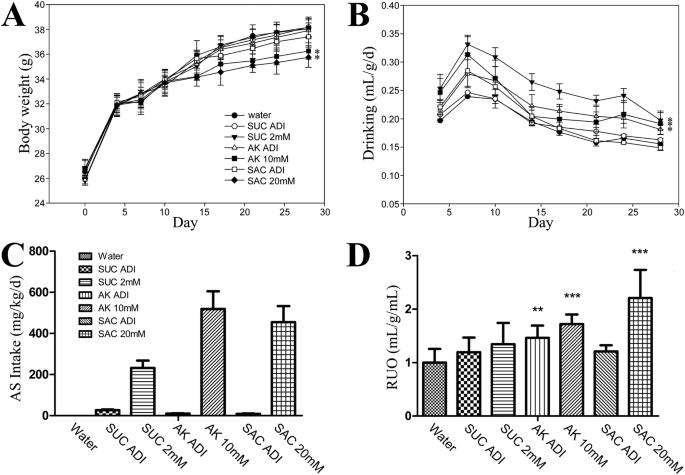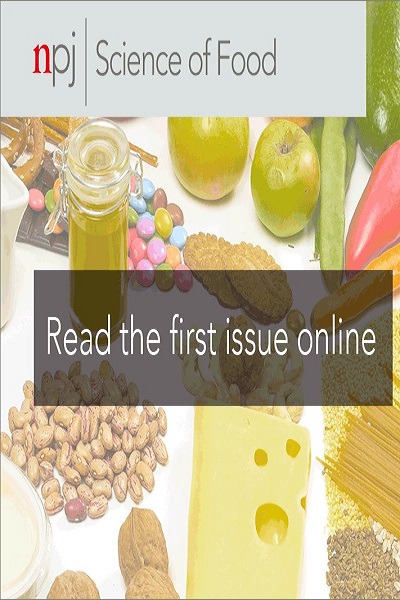Sweet taste receptors play roles in artificial sweetener-induced enhanced urine output in mice
IF 6.3
1区 农林科学
Q1 FOOD SCIENCE & TECHNOLOGY
引用次数: 0
Abstract
Sweet taste receptors found in oral and extra oral tissues play important roles in the regulation of many physiological functions. Studies have shown that urine volume increases during the lifetime exposure to artificial sweeteners. However, the detailed molecular mechanism and the general effects of different artificial sweeteners exposure on urine volume remain unclear. In this study, we investigated the relationship between urinary excretion and the sweet taste receptor expression in mice after three artificial sweeteners exposure in a higher or lower concentration via animal behavioral studies, western blotting, and real-time quantitative PCR experiment in rodent model. Our results showed that high dose of acesulfame potassium and saccharin can significantly enhance the urine output and there was a positive correlation between K+ and urination volume. The acesulfame potassium administration assay of T1R3 knockout mice showed that artificial sweeteners may affect the urine output directly through the sweet taste signaling pathway. The expression of T1R3 encoding gene can be up-regulated specifically in bladder but not in kidney or other organs we tested. Through our study, the sweet taste receptors, distributing in many tissues as bladder, were indicated to function in the enhanced urine output. Different effects of long-term exposure to the three artificial sweeteners were shown and acesulfame potassium increased urine output even at a very low concentration.


甜味受体在人工甜味剂诱导的小鼠尿量增加中发挥作用。
在口腔和口腔外组织中发现的甜味受体在许多生理功能的调节中发挥着重要作用。研究表明,人在一生中接触人造甜味剂后,尿量会增加。然而,不同人工甜味剂暴露对尿量影响的详细分子机制和一般影响仍不清楚。在本研究中,我们通过动物行为学研究、Western 印迹和啮齿动物模型实时定量 PCR 实验,研究了小鼠暴露于三种高浓度或低浓度人工甜味剂后,尿液排泄与甜味受体表达之间的关系。结果表明,高剂量安赛蜜钾和糖精能显著增加小鼠的尿量,K+与尿量呈正相关。对 T1R3 基因剔除小鼠进行安赛蜜钾给药试验表明,人工甜味剂可能通过甜味信号通路直接影响尿量。T1R3编码基因在膀胱中的表达可以特异性上调,而在肾脏或其他器官中则没有上调。通过我们的研究,甜味受体与膀胱一样分布在许多组织中,它们在尿量增加中起作用。长期接触三种人造甜味剂会产生不同的影响,安赛蜜钾即使在浓度很低的情况下也会增加尿量。
本文章由计算机程序翻译,如有差异,请以英文原文为准。
求助全文
约1分钟内获得全文
求助全文
来源期刊

NPJ Science of Food
FOOD SCIENCE & TECHNOLOGY-
CiteScore
7.50
自引率
1.60%
发文量
53
期刊介绍:
npj Science of Food is an online-only and open access journal publishes high-quality, high-impact papers related to food safety, security, integrated production, processing and packaging, the changes and interactions of food components, and the influence on health and wellness properties of food. The journal will support fundamental studies that advance the science of food beyond the classic focus on processing, thereby addressing basic inquiries around food from the public and industry. It will also support research that might result in innovation of technologies and products that are public-friendly while promoting the United Nations sustainable development goals.
 求助内容:
求助内容: 应助结果提醒方式:
应助结果提醒方式:


